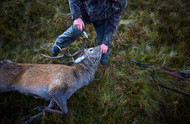Field Dressing Basics: What Every Hunter Should Know
7th Oct 2025
For hunters, the work doesn’t end when the animal is harvested. One of the most important skills to learn is field dressing—the process of removing the internal organs from game in the field. Done properly, it preserves the quality of the meat, makes the animal easier to transport, and prevents spoilage. If you’re new to hunting, here are the basics you need to know.
Why Field Dressing Matters
- Keeps meat clean and cool: Removing the organs helps the carcass cool faster, which prevents bacteria growth.
- Easier to handle: A dressed animal is lighter and easier to carry.
- Improves taste: Proper dressing reduces the chance of tainting meat with stomach contents or fluids.
Essential Tools
- Sharp knife: A fixed blade or folding hunting knife with a sturdy edge.
- Gloves: Protect your hands and keep things sanitary.
- Game bags or tarp: To keep meat clean once processed.
- Optional: Small saw for larger game, rope for positioning.
Step-by-Step Basics
- Position the Animal
Lay the deer (or other game) on its back with the head uphill if possible. Spread the legs for easier access. - Make the Initial Cut
Starting at the pelvis, make a shallow cut up the belly toward the sternum. Be careful to cut only the skin and muscle—avoid puncturing the stomach or intestines. - Open the Body Cavity
Carefully work your knife along the midline. Some hunters use two fingers to lift the skin as they cut, guiding the blade upward to avoid cutting into organs. - Remove the Organs
- Cut the diaphragm (the thin membrane separating chest and abdomen).
- Reach up into the chest cavity to cut the windpipe and esophagus, then pull downward.
- Gently roll or pull the organs out, being mindful of the bladder and intestines to prevent spillage.
- Drain and Clean
Tip the carcass slightly to allow any fluids to drain. Wipe or rinse with clean water if available, but avoid soaking the meat. - Cool the Carcass
Prop open the chest cavity with a stick or rock to allow air circulation. The faster the carcass cools, the better the meat quality.
Tips for Beginners
- Take your time—speed comes with practice.
- Always cut away from yourself for safety.
- If you’re unsure, many hunters recommend practicing under the guidance of an experienced mentor the first time.
- Watch the wind: standing upwind helps avoid unnecessary odors.
Field dressing is a vital skill every hunter should master. With the right tools, a steady hand, and a focus on keeping the process clean, you’ll protect the quality of your harvest and ensure it makes it from the field to the table in the best condition possible. Like most outdoor skills, it becomes easier each time you practice—and it’s one of the most rewarding parts of being a self-reliant hunter.

